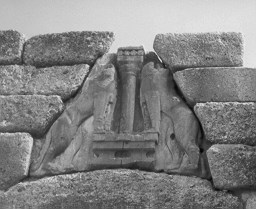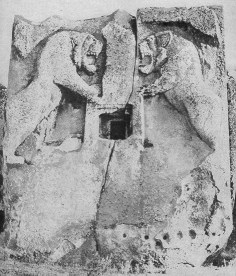The Lion Gate of Mycenae
The Lion Gate
of Mycenae was the entrance to the city. Atop the gate, two lions rampant
are carved in stone relief. Similar bas-reliefs of two lions rampant facing
each other are found in a number of places in Phrygia in Asia Minor.1
 |
 |
|
|
The
Lion Gate of Mycenae
|
Arslantas,
Rock-cut Phrygian tomb
|
“The resemblance in idea is complete,” wrote W. M. Ramsay in 1888. 2 He considered the scheme “so peculiarly characteristic of Phrygia, that we can hardly admit it to have been borrowed from any other country.” He found himself “driven to the conclusion that the Mycenaean artists either are Phrygians or learned the idea from the Phrygians.”3 “It is not allowable to separate them [the Phrygian and Mycenaean monuments] in time by several centuries.”4
“The Phrygian monuments,” in Ramsay’s view, belong to the ninth and eighth centuries.5
. . . The end of the Phrygian kingdom is a fixed date, about 675 B.C.”6 when the invasion of Asia Minor by the Cimmerians put an end to the Phrygian culture and art. Ramsay went on:
I do not think it is allowable to place the Mycenaean gateway earlier than the ninth, and it is more likely to belong to the eighth century.
The view to which I find myself forced is as follows. There was in the eighth century lively intercourse between Argos and Asia Minor: in this intercourse the Argives learned . . . to fortify their city in the Phrygian style with lions over the gate. Historically there is certainly good reason to assign at least part of the fortifications of Mycenae to the time when the Argive kings [the tyrants of the eighth century] were the greatest power in Greece [here follow the names of several authorities among the historians who hold the same view].8
On the other hand, the almost universal opinion of archaeologists rejects this hypothesis. . . .
I quote this opinion of Ramsay with the special intention of showing how this viewpoint was invalidated.
The Egyptologist Flinders Petrie made the following reply:
“[A] matter which demands notice is Professor Ramsay’s conclusion that the lion gateway is of as late a date as the eighth century B.C. This results from assuming it to be derived from Phrygian lion groups, on the ground of not knowing of any other prototype. As however we now have a wooden lion, in exactly the same attitude, dated to 1450 in Egypt . . . it seems that the Phrygian designs are not the only source of this motive for Mykenae.”10
In Egypt of the latter part of the Eighteenth Dynasty a single instance of a rampant lion (not two rampant lions facing each other as at Mycenae and in Phrygia) made Petrie claim Egypt as a possible place of origin of this image rather than Phrygia. He had discovered heaps of Mycenaean ware in Egypt of the time of Akhnaton. He could not but conclude that these heaps coming from Mycenae must be dated to the fourteenth century.11
Equally impressive was the discovery at Mycenae of a number of objects of Eighteenth-Dynasty date, such as objects bearing the cartouches of Amenhotep II, Amenhotep III, and Queen Tiy.12
Therefore Petrie decidedly opposed Ramsay in his estimate of eighth century for the Lion Gate and the fortification wall of Mycenae.13
Here is a case where evidence from Anatolia pointed to the eighth century;14 but the Egyptologist demanded of the classical scholar that he disregard this evidence in favor of the time scale of Egypt.
The debate between Ramsay and Petrie took place before Evans’ archaeological work on Crete; there rampant lions were found engraved on Late Minoan gems,15 conveying the idea that Mycenae must have borrowed the image from there, from a period well preceding the Phrygian models.16 Yet one should not lose sight of the fact that Crete’s chronology was also built upon relations with Egypt. In the section “The Scandal of Enkomi” we shall read how Evans objected to the chronological implications of Cypriote archaeology by stressing relations between the Egyptian and the Minoan (Cretan) chronologies on the one hand, and Minoan and Cypriote on the other. In Ages in Chaos it was shown in great detail why the end of the Eighteenth Dynasty of Egypt must be placed in the latter part of the ninth century. Thus even if Crete was the original source of the motif, Mycenae and Phrygia both deriving it thence, the dependence of Cretan chronology on that of Egypt constitutes the crux of the problem.17
Let us keep in mind that in the 1880s and 1890s classical scholars of the stature of W. M. Ramsay (1851-1939) questioned the inclusion of the Dark Ages of several hundred years’ duration between the Mycenaean past and the Ionic age in Greece. And let us not overlook what was the supposedly crushing argument for wedging more than half a millennium into the history of ancient Greece.
References
-
Cf. especially the relief on the “Lion Tomb” at Arslan Tash near Afyonkarahisar (fig.)
-
Ramsay, “A Study of Phrygian Art,” Journal of Hellenic Studies IX (1888), p. 369. [Ramsay, “Studies in Asia Minor,” Journal of Hellenic Studies III (1882), p. 19—but see G. Mylonas, Mycenae and the Mycenaean Age (Princeton, 1966), p. 173.]
-
Ramsay, “A Study of Phrygian Art,” pp. 369-370. [Earlier representations of two rampant lions facing each other are known from Crete; however, it is for the carving technique on stone on a monumental scale that Mycenae seems to be indebted to Phrygia. For a link to Assyria, see L. M. Greenberg, “The Lion Gate at Mycenae,” Pensée IVR III, p. 26.]
-
[Emilie Haspels in Highlands of Phrygia (Princeton, 1971) dates the Phrygian reliefs at Arslan Tash to “the last third of the eighth century B.C., the period of the ‘Phrygian City’ of Gordion” (vol. I, p. 135; cf. vol. II, pl. 131-32). E. Akurgal, however, puts the same reliefs in the early sixth century, deriving them from Ionian, and ultimately Egyptian models—Die Kust Anatoliens von Homer bis Alexander (Berlin, 1961) pp. 86-90, 95. EMS ].
-
[Ramsey considered the Mycenaean relief “much more advanced in art” though “not necessarily later in date” than the Phrygian Lion Tomb: “Some Phrygian Monuments,” Journal of Hellenic Studies III (1882) p. 257. For evidence of Phrygian influence on eighth-century Greece, see R. S. Young, “The Nomadic Impact: Gordion” in Dark Ages and Nomads c. 1000 B.C.: Studies in Iranian and Anatolian Archaeology, ed. by M. J. Mellink (Leiden, 1964), p. 54.]
-
U. v. Wilamowitz-Moellendorf, “Oropos und die Graer,” Hermes XXI (1886), p. 111, n. 1, and idem, Isyllos von Epidauros (Berlin, 1886), p. n.1; B. Niese, Die Entwicklung der homerischen Poesie (Berlin, 1882), p. 213, n. 1. A. S. Murray and S. Reinach are also among those cited by Ramsay as concurring with his opinion (p. 370, n. 3).
-
Sir W. M. Flinders Petrie, “Notes on the Antiquities of Mykenae,” Journal of Hellenic Studies XII (1891), pp. 202-03. [Petrie also attempted to fix the dates of many of the finds from the Mycenaean tombs by comparing them with objects from Egypt whose antiquity he considered to be well-established.]
-
Cf. J. D. S. Pendlebury, Aegyptiaca (Cambridge, 1930), pp. 111ff. [V. Hankey and P. Warren, “The Absolute Chronology of the Aegean Late Bronze Age,” Bulletin of the Institute of Classical Studies (University of London) XXI (1974), pp. 142-152.]
-
Cf. Pendlebury, Aegyptiaca, pp. 53-57; Hankey and Warren, “The Absolute Chronology of the Aegean Late Bronze Age.”
-
Boardman notes that monumental sculpture of this kind is unknown in Greece from the time the Lion Gate of Mycenae was built until the eighth century: “More than five hundred years were to pass before Greek sculptors could [again] command an idiom that would satisfy these aspirations in sculpture and architecture.” Greek Art (New York, 1964), p. 22. [A few other 500-year enigmas appear at Mycenae. See below, Supplement, “Applying the Revised Chronology,” by Edwin Schorr.]
-
[In The Sea People Sandars points out the stylistic similarity between the Lion Gate of Mycenae and the Lion Gate of Boghazkoi. EMS]
-
[Some of these gems were known even before Evans’ digs—see for instance the intaglio in G. Perrot and C. Chipiez, History of Art in Primitive Greece II (London, 1894), pp. 214 and 246, depicting two rampant lions facing each other in a way similar to that on the Lion Gate. Cf. also the gems shown in Corpus der minoischen und mykenischen Siegel, ed. F. Matz and H. Bisantz (Berlin, 1964) nos. 46, 144, 145, 172.]
-
[N. Platon, (“Cretan-Mycenaean Art,” Encyclopaedia of World Art IV [New York, 1958], p. 109) thought that “the technique of the execution [of the Lion Gate] is clearly inspired by Cretan sculpture.” But the Cretan sculptures, unlike those in Phrygia, are miniatures, and Platon needs to assume “the effective translation of a miniature theme into a major sculptural creation” (R. Higgins, Minoan-Mycenaean Art [New York, 1967], p. 92). Sandars in The Sea Peoples points out the similarity of the monumental carving style of the Lion Gate of Boghazkoi in central Anatolia to the Lion Gate of Mycenae.]
-
[The discovery of Late Helladic IIIB pottery in strata excavated underneath the gate is used to establish the date of its construction.] But this pottery, too, is dated on the basis of relations with Egypt.


